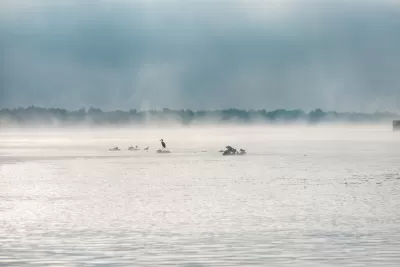President Trump's budget for 2018 has the U.S. Environmental Protection Agency take the steepest hit—31 percent. Funding for two vital programs, the Great Lakes Restoration Initiative and Chesapeake Bay Program, will have their funds eliminated.

[Updated March 21, 2017] To fund a $52 billion increase in defense spending, President Trump's budget will greatly reduce discretionary domestic spending. No agency will suffer a greater percentage drop than the U.S. Environmental Protection Agency: a loss of $2.6 billion from current levels, reports The New York Times on March 16.
The budget calls for the elimination of about 3,200 staff positions — over 20 percent of the department.
Among the other departments to see their budgets reduced:
- Health and Human Services: $12.6 billion (-16%)
- Housing and Urban Development: $4.3 billion (-12%)
- Transportation: $2.4 billion (-13%)
"The Trump administration has proposed eliminating U.S. EPA cleanup initiatives for the Chesapeake Bay and Great Lakes, but it would maintain funding for the agency's drinking water infrastructure programs," reports Ariel Wittenberg for E&E News.
"The budget returns the responsibility for funding local environmental efforts and programs to the State and local entities, allowing EPA to focus on its highest national priorities," the administration's budget request says.
Chesapeake Bay Program
"Trump's budget would slash funds for Chesapeake Bay cleanup from $73 million a year to $0," reports
Trump's budget zeroes out the $300 million EPA budget for this program, convened in 2010 under the EPA under President Obama "to accelerate efforts to protect and restore the largest system of fresh surface water in the world — the Great Lakes," according to the program's website.
The program enjoys bipartisan support. “It makes sense for us to continue to make prudent investments in protecting and improving the Great Lakes,” Gov. Scott Walker, Republican of Wisconsin, told the Associated Press. "The Great Lakes are an invaluable resource to Ohio, and The Great Lakes Restoration Initiative has been a successful public-private partnership that helps protect both our environment and our economy," stated Sen. Rob Portman, Republican of Ohio, in a press release.
Cutting the funding would have repercussions with our northern neighbor, reports Dan Levin for The New York Times, which contributes $10 million annually to the project.
The budget proposal...has dismayed the Canadian government, which cooperates with the United States to clean up and protect the Great Lakes. The lakes are the source of drinking water for 45 million people — including 10 million in Ontario, about 90 percent of its population. Ontario has the largest shoreline on the Great Lakes of any jurisdiction in Canada and the United States.
Drinking water and wastewater infrastructure
"The Trump budget does propose maintaining EPA's drinking water infrastructure programs," reports E&E's Wittenberg. "The budget requests $20 million for the Water Infrastructure Finance and Innovation Act loan program — the same amount provided by the 2017 continuing resolution."
The WIFIA program has been compared to the popular Transportation Infrastructure Finance and Innovation Act (TIFIA) Program.
Other similar programs did not fare as well.
The Department of Agriculture's water and wastewater loan and grant program would be zeroed out to save $498 million from current levels.
Cutting the aforementioned programs would be "a bloodbath budget," said Erik D. Olson, director of the health and environment programs at the Natural Resources Defense Council. "He said the cumulative effect of cutting programs like USDA's loan program, the Great Lakes initiative and enforcement would be devastating."
The president's budget is a considered a blueprint as Congress has the final word. The Associated Press explains the budget-making process in greater detail. If the president and Republican majority in Congress do not come to an agreement, a government shutdown is possible. An extension of current government spending is needed by April 29 to avoid a partial shutdown.
[Updated to correct the amount cut from the budget of the Department of Transportation.]
FULL STORY: Budget would end EPA funding for Chesapeake Bay, Great Lakes

Alabama: Trump Terminates Settlements for Black Communities Harmed By Raw Sewage
Trump deemed the landmark civil rights agreement “illegal DEI and environmental justice policy.”

Study: Maui’s Plan to Convert Vacation Rentals to Long-Term Housing Could Cause Nearly $1 Billion Economic Loss
The plan would reduce visitor accommodation by 25% resulting in 1,900 jobs lost.

Why Should We Subsidize Public Transportation?
Many public transit agencies face financial stress due to rising costs, declining fare revenue, and declining subsidies. Transit advocates must provide a strong business case for increasing public transit funding.

Paris Bike Boom Leads to Steep Drop in Air Pollution
The French city’s air quality has improved dramatically in the past 20 years, coinciding with a growth in cycling.

Why Housing Costs More to Build in California Than in Texas
Hard costs like labor and materials combined with ‘soft’ costs such as permitting make building in the San Francisco Bay Area almost three times as costly as in Texas cities.

San Diego County Sees a Rise in Urban Coyotes
San Diego County experiences a rise in urban coyotes, as sightings become prevalent throughout its urban neighbourhoods and surrounding areas.
Urban Design for Planners 1: Software Tools
This six-course series explores essential urban design concepts using open source software and equips planners with the tools they need to participate fully in the urban design process.
Planning for Universal Design
Learn the tools for implementing Universal Design in planning regulations.
Smith Gee Studio
Alamo Area Metropolitan Planning Organization
City of Santa Clarita
Institute for Housing and Urban Development Studies (IHS)
City of Grandview
Harvard GSD Executive Education
Toledo-Lucas County Plan Commissions
Salt Lake City
NYU Wagner Graduate School of Public Service





























